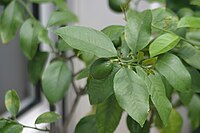
Papilio glaucus, the eastern tiger swallowtail, is a species of butterfly native to eastern North America. It is one of the most familiar butterflies in the eastern United States, ranging north to southern Ontario, Canada, and is common in many different habitats. It flies from spring until fall, during which it produces two to three broods. Adults feed on the nectar of many species of flowers, mostly from those of the families Apocynaceae, Asteraceae, and Fabaceae. P. glaucus has a wingspan measuring 7.9 to 14 cm. The male is yellow with four black "tiger stripes" on each forewing. Females may be either yellow or black, making them dimorphic. The yellow morph is similar to the male, but with a conspicuous band of blue spots along the hindwing, while the dark morph is almost completely black.
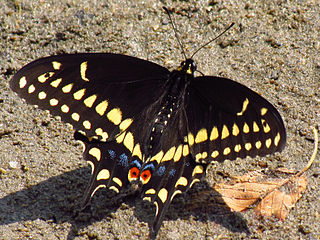
Papilio polyxenes, the (eastern) black swallowtail, American swallowtail or parsnip swallowtail, is a butterfly found throughout much of North America. An extremely similar-appearing species, Papilio joanae, occurs in the Ozark Mountains region, but it appears to be closely related to Papilio machaon, rather than P. polyxenes. The species is named after the figure in Greek mythology, Polyxena, who was the youngest daughter of King Priam of Troy. Its caterpillar is called the parsley worm because the caterpillar feeds on parsley.

Papilio demoleus is a common and widespread swallowtail butterfly. The butterfly is also known as the lime butterfly, lemon butterfly, lime swallowtail, and chequered swallowtail. These common names refer to their host plants, which are usually citrus species such as the cultivated lime. Unlike most swallowtail butterflies, it does not have a prominent tail. When the adult stage is taken into consideration, the lime swallowtail is the shortest-lived butterfly, with male adults dying after four days and females after a week. The butterfly is native to Asia and Australia, and can be considered an invasive pest in other parts of the world. The butterfly has spread to Hispaniola island in the Western Hemisphere, and to Mahé, Seychelles.

Papilio protenor, the spangle, is a butterfly found in India belonging to the swallowtail family.

The giant swallowtail is the largest butterfly in North America. It is abundant through many parts of eastern North America; populations from western North America and down into Panama are now considered to belong to a different species, Papilio rumiko. Though it is often valued in gardens for its striking appearance, its larval stage can be a serious pest to citrus farms, which has earned its caterpillars the names orange dog or orange puppy. The giant swallowtail caterpillars possess remarkable camouflage from predators by closely resembling bird droppings. They use this, along with their osmeteria, to defend against predators such as wasps, flies, and vertebrates.

Papilio demodocus, the citrus swallowtail or Christmas butterfly, is a swallowtail butterfly which commonly occurs over the entirety of sub-Saharan Africa, including Madagascar, besides the southern Arabian Peninsula. The caterpillars feed on various native plants of especially the family Rutaceae, but have also taken to the leaves of cultivated citrus trees.

Papilio ulysses, the Ulysses butterfly, is a large swallowtail butterfly of Australia, Indonesia, Papua New Guinea and the Solomon Islands. Its size varies depending on subspecies, but the wingspan is about 10.5 cm (4.1 in) in Queensland.

Papilio weymeri is a species of swallowtail butterfly in the Papilioninae subfamily that is endemic to Papua New Guinea where it is found on Los Negros and Manus Islands.
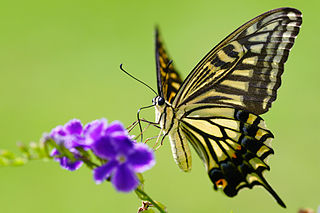
Papilio xuthus, the Asian swallowtail, Chinese yellow swallowtail, Japanese Swallowtail, or Xuthus swallowtail, is a yellow-colored, medium to large sized swallowtail butterfly found in northeast Asia, northern Myanmar, southern China, Taiwan, the Korean Peninsula, Japan, Siberia and the Hawaiian Islands. The butterfly has been observed once in Dunedin, New Zealand in 1996 emerging from a chrysalis in a car yard specializing in Japanese used cars; it is thought the chrysalis arrived through one of the cars. It was also recorded in the state of Arunachal Pradesh, India, in 2014.

Papilio anactus, the dainty swallowtail, dingy swallowtail or small citrus butterfly is a medium-sized butterfly from the family Papilionidae, that is endemic to Australia.

Papilio palamedes, the Palamedes swallowtail or laurel swallowtail, is a North American butterfly in the family Papilionidae.
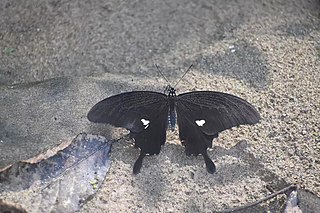
Papilio noblei is a butterfly of the family Papilionidae. It is found in Southeast Asia, from Burma to Vietnam. Recently, this species was also sighted in Namdapha National Park, India.

Papilio woodfordi, the Woodford's swallowtail, is a swallowtail butterfly of the Papilioninae subfamily. It is found on various islands in the Pacific Ocean.

Papilio torquatus, the torquatus swallowtail, is a swallowtail butterfly in the subfamily Papilioninae. It is found from northern Argentina to Mexico.

Papilio androgeus, the Androgeus swallowtail, queen page, or queen swallowtail, is a Neotropical butterfly of the family Papilionidae. It is found from Mexico to Argentina with a small population in southern Florida.

Papilio bridgei is a swallowtail butterfly of the Papilioninae subfamily. It is found on various islands in the Solomons group. It is not threatened.

Papilio euchenor is a butterfly of the family Papilionidae.
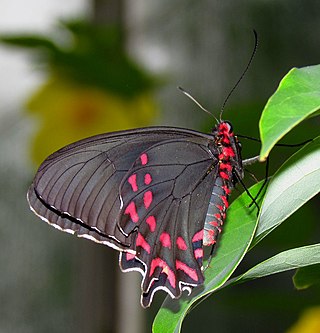
Parides photinus, the pink-spotted cattleheart, is a species of butterfly in the family Papilionidae. It was first described by Edward Doubleday in 1844.

Papilio gambrisius is a species of swallowtail butterfly from the genus Papilio that is found in Serang, Moluccas, Ambon Island, Seram and Buru.

Papilio ptolychus is a species of swallowtail butterfly from the genus Papilio that is found on Guadalcanal and Florida Island.











